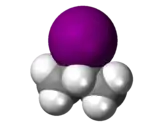 | |
 | |
| Names | |
|---|---|
| Preferred IUPAC name
2-Iodopropane[1] | |
| Identifiers | |
3D model (JSmol) |
|
| 1098244 | |
| ChemSpider | |
| ECHA InfoCard | 100.000.782 |
| EC Number |
|
| MeSH | isopropyl+iodide |
PubChem CID |
|
| RTECS number |
|
| UNII | |
| UN number | 2392 |
CompTox Dashboard (EPA) |
|
| |
| |
| Properties | |
| C3H7I | |
| Molar mass | 169.993 g·mol−1 |
| Appearance | Colourless liquid |
| Density | 1.703 g mL−1 |
| Melting point | −90.00 °C; −130.00 °F; 183.15 K |
| Boiling point | 88.8 to 89.8 °C; 191.7 to 193.5 °F; 361.9 to 362.9 K |
| 1.4 g L−1 (at 12.5 °C) | |
| Solubility in chloroform | Miscible |
| Solubility in ethanol | Miscible |
| Solubility in diethyl ether | Miscible |
| Solubility in benzene | Miscible |
Henry's law constant (kH) |
890 nmol Pa−1 kg−1 |
Refractive index (nD) |
1.4997 |
| Viscosity | 6.971 mPa (at 20 °C) |
| Thermochemistry | |
Heat capacity (C) |
137.3 J K−1 mol−1 |
Std enthalpy of formation (ΔfH⦵298) |
−77.2–−72.6 kJ mol−1 |
| Hazards | |
| GHS labelling: | |
  | |
| Warning | |
| H226, H302 | |
| Flash point | 42 °C (108 °F; 315 K) |
| Related compounds | |
Related alkanes |
|
Related compounds |
Diiodohydroxypropane |
Except where otherwise noted, data are given for materials in their standard state (at 25 °C [77 °F], 100 kPa).
Infobox references | |
Isopropyl iodide is the organoiodine compound with the formula (CH3)2CHI. It is colorless, flammable, and volatile. Organic iodides are light-sensitive and take on a yellow colour upon storage, owing to the formation of iodine.
Preparation
Isopropyl iodide is prepared by iodination of isopropyl alcohol using hydrogen iodide or, equivalently, with a mixture of glycerol, iodine, and phosphorus.[2] An alternative preparation involves the reaction of 2-propyl bromide with an acetone solution of sodium iodide (Finkelstein reaction):[3]
- (CH3)2CHBr + NaI → (CH3)2CHI + NaBr
References
- ↑ "isopropyl iodide - Compound Summary". PubChem Compound. USA: National Center for Biotechnology Information. 27 March 2005. Identification and Related Records. Retrieved 3 March 2012.
- ↑ Merck Index of Chemicals and Drugs, 9th ed., monograph 5074
- ↑ Textbook of Practical Organic Chemistry, 5th Edition, Prentice Hall, 1989
This article is issued from Wikipedia. The text is licensed under Creative Commons - Attribution - Sharealike. Additional terms may apply for the media files.